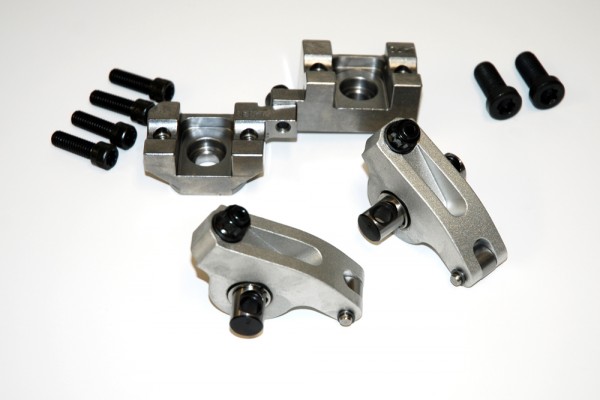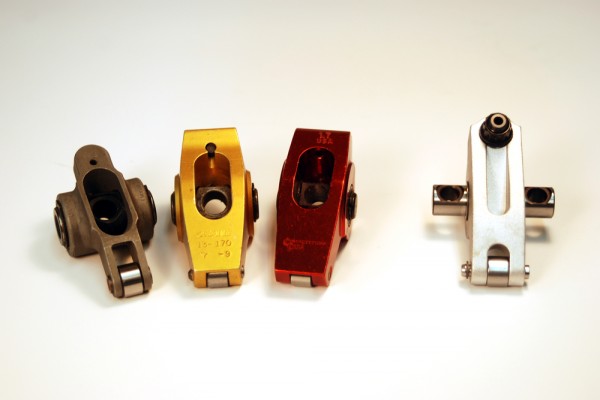When Chevy’s small block debuted in 1955, it didn’t take long for it to be regarded as a marvel of performance engineering, particularly when it came to its innovative valvetrain. Its lightweight, ball and stud, stamped rocker arm configuration allowed it to turn unheard of (for that era) engine speeds. It wasn’t long before examples with solid lifter cams nudged the tach to 7,000 rpm or so on each of the gear changes. That was a bunch back then, especially for a pushrod engine.
Naturally, racers began to push the performance envelope even further with stiffer valve springs, more-aggressive camshafts, and poly-locks to maintain valve lash. Soon, rocker studs were pulling out of the heads. To remedy the situation, hot rodders would pin the studs or make the switch to screw-in rocker studs. Eventually, the stud girdle was invented to handle higher spring pressures and highly aggressive cam profiles.
Rise of the Shaft-Mount Rocker
The stud girdle essentially ties the valvetrain together and eliminates excess movement, but it can also create a headache when it comes time to set the valves. Typically, you first loosen the stud girdle, and then you lash the valves. The girdle is re-tightened and finally most folks check the valve lash once more. If the studs are the least bit out of alignment, tightening the stud girdle changes the valve lash. If you have one, you know the drill (and it’s not fun). And then there’s the issue of clearance on some combinations—the rockers and girdle can touch and cause a whole lot of grief!
And here’s something else to ponder:
In a small block Chevy application, the stock rocker has a relatively short pivot length. This implies the arc it travels in is small, particularly in comparison to other engines (Jesel notes that the stock small block has a rocker pivot length of 1.40 inches; the big block has a pivot length of 1.65 inches). This means the stock small block rocker arm tip scrubs across the tip of the valve as it opens. While this isn’t much of an issue at lower gross valve lifts, you’ll encounter a huge problem when you dramatically increase the lift and/or spring pressure: increased friction.
How much?
Many years ago, Dan Jesel relocated the rocker studs away from the valves on a small block Chevy, so he could install a set of big block rocker arms. In a simple rotating torque test, it took 80 ft.-lbs. less torque to rotate the small block with big block rockers in comparison to the stock small block rocker arms. While Jesel’s test proved to be insightful, it’s just not that easy to relocate rocker studs on an engine to gain pivot length. The harsh reality is it’s far easier to build an entirely new rocker arm arrangement.
Enter today’s shaft rockers, which offer four major advantages over stud mount rockers:
More Stability
Obviously, a considerable reduction in friction is huge, but a shaft rocker also offers far more stability at high rpm.
Using the small block Chevy as an example, the pushrod, the rocker stud, and the valve are not always in line. This isn’t much of an issue with stock stamped rockers and low valve lifts, since the stock rocker can more or less compensate. However, a conventional stud mount roller rocker replacement cannot “fix” the misalignment on more aggressive engines. Since shaft rockers allow you to adjust geometry, they are inherently more stable at higher rpm.
Increased Reliability
Reliability is a big bonus with shaft rockers, too.
A stud mount rocker slides up and down the stud, taking up the valve lash prior to opening the valve. At high engine speeds, the rocker acts like a slide hammer trying to peel the rocker stud right out of the head. Shaft rockers tend to be much easier on valve guides, valve seats, and valve tips, since the longer pivot length in a shaft rocker doesn’t side-load the valve as much as a stud mount rocker.
Added Ratio Options
Ratio choice is another big benefit.
Rocker arm ratio is determined by the relationship between the pushrod cup, the rocker shaft centerline, and the roller tip. In a shaft rocker, assorted pivot lengths can accommodate a wide range of ratios from 1.5:1 through to 2.25:1. That wide range simply isn’t practical in a stud mount rocker.
So is increased rocker ratio important?
Absolutely. That’s why a number of engine builders in all forms of motorsports (drag racing, oval track and endurance racing) turn to the rocker arm instead of the camshaft as a means to increase valve lift. The use of varying ratio rocker arms allows for finite “tuning” on a per-cylinder basis. Plus, it allows you to test the power levels of varied net valve lift without the cost and time constraints of cam swaps.
Better Valvetrain Geometry
The biggest bonus with shaft rockers is the ultimate improvement in the geometry of the valvetrain.
In order to change valvetrain geometry you have to move the rocker’s pivot point. Again, that is simply impractical with stud mount rockers; however, with a shaft system, the rocker pivot is moved further away from the valve to allow a longer rocker “pivot length.” In some shaft rocker systems (Jesel systems, for example), the manufacturer lowers the pivot point as well for a low pivot arc from half to full-valve lift—right where spring pressures are the highest. This improved geometry eliminates much of the friction caused by the rocker “scrubbing” across the valve tip. Obviously, the big gains here are in both power and reliability.
In the end, today’s rocker arm technology just may be the primary reason why the “old-fashioned” pushrod engine is still hugely competitive today.


















Going to shaft rockers on my BBC. The girdle was a pain. Don’t even get me started on checking valve spring pressures.
In the course of my BBC build I did a swap from 1.7 to 1.8 and picked up 15hp. Now I am in the process of increasing the pivot angle from 1.650 to 1.750 and ratio 1.8 to 1.95. My idea
is to gain lift and duration without a cam swap. I am running a hydrolic roller sem-aggressive
cam and want a little more punch.
T&D rockers
How does the Dodge system compared to what you’re talking about